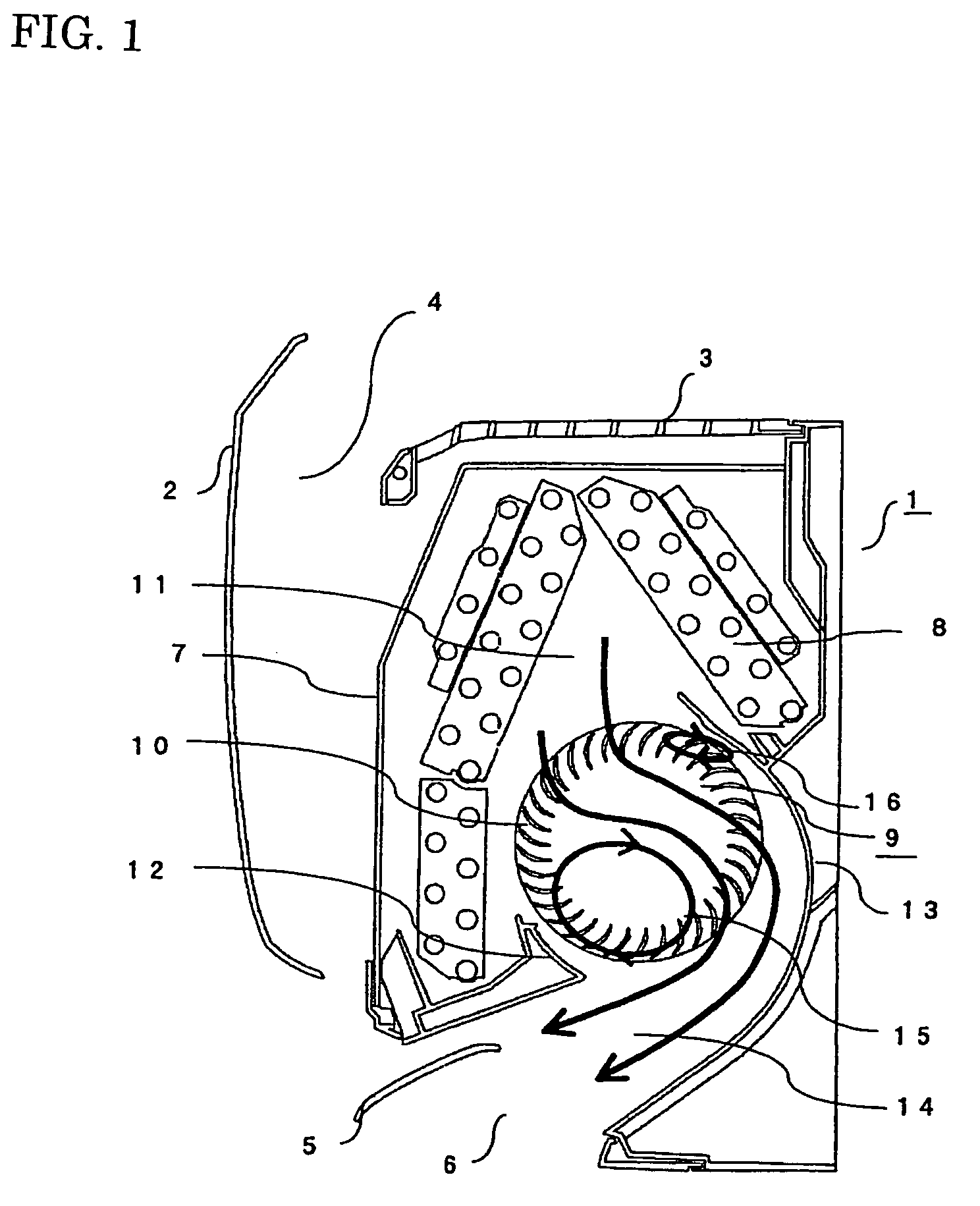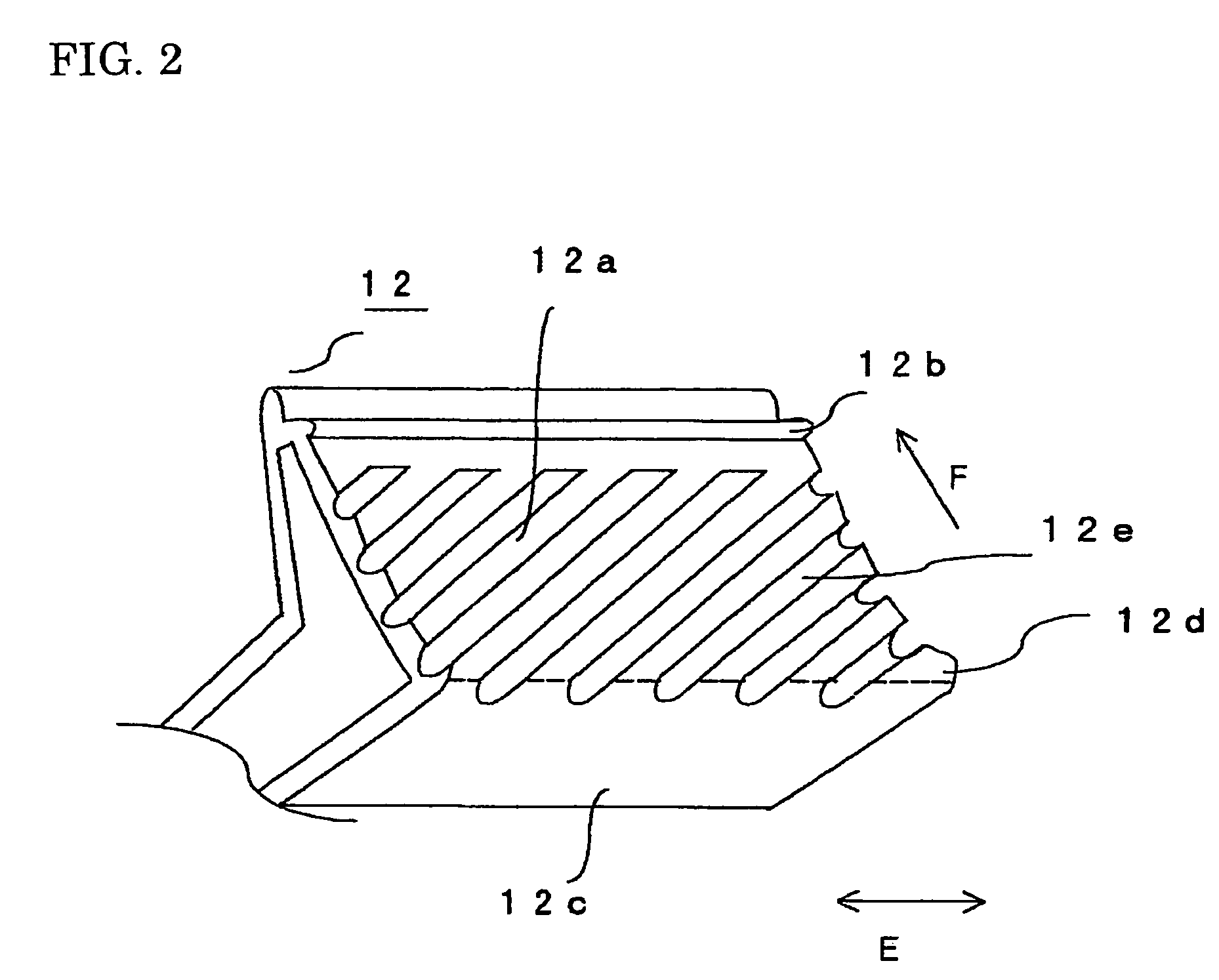Air conditioner
a technology for air conditioners and fans, applied in the field of air conditioners, can solve the problems of deteriorating blowing performance, reverse inhalation from the outlet toward the outlet, deteriorating blowing efficiency, etc., and achieve the effects of reducing noise, preventing deterioration in blowing performance, and preventing the generation of reverse inhalation
- Summary
- Abstract
- Description
- Claims
- Application Information
AI Technical Summary
Benefits of technology
Problems solved by technology
Method used
Image
Examples
first embodiment
[0040]FIG. 1 is a sectional view of an indoor unit of an air conditioner according to a first embodiment of the present invention. In the drawing, the indoor unit 1 of the air conditioner is installed in a room, and an air inlet 4 covered with a front panel 2 and a top grill 3 is provided at the upper front of the indoor unit 1 so as to oppose the room inside. Also, an air outlet 6 having an opening restricted in direction and area with a wind-direction adjusting vane 5 is provided at the lower front of the unit. Sequentially, an air flow-path extending from the air inlet 4 to the air outlet 6 is formed. In the midstream of the air flow-path, a pre-filter 7 for eliminating foreign materials contained in the flowing room air, a heat exchanger 8 for exchanging heat between refrigerant flowing through piping and the flowing room air, and a cross-flow fan 9 are arranged. The cross-flow fan 9 is composed of a cylindrical fan body extending in the direction of the rotational axis, includi...
second embodiment
[0082]An indoor unit of an air conditioner according to a second embodiment of the present invention will be described. The sectional structure of the indoor unit according to the embodiment is the same as that shown in FIG. 1, and the air conditioning operation by changing air quality in a room is also the same as that according to the first embodiment, so that the descriptions are omitted.
[0083]When considering the gap between the impeller 10 and the casing 13, the narrower the gap, the air flowing through the gap is more stabilized, improving the blowing efficiency. However, broad band noise due to the collision of the high-speed air blowing off out of the impeller 10 with the casing 13 is increased. Conversely, the broader the gap between the impeller 10 and the casing 13, the broad band noise is more reduced. However, the air flowing through the gap becomes unstable, deteriorating the blowing efficiency and generating the back flow from the outlet toward the impeller 10. That i...
third embodiment
[0114]An indoor unit of an air conditioner according to a third embodiment of the present invention will be described. The sectional structure of the indoor unit according to the embodiment is the same as that shown in FIG. 1, and the air conditioning operation by changing air quality in a room is also the same as that according to the first embodiment, so that the descriptions are omitted.
[0115]FIG. 16 is a perspective view of the cross-flow fan 9 according to the embodiment, in which like reference characters designate like components equivalent or common to FIGS. 2 and 11. FIG. 17(a) is a front view of the stabilizer 12 viewed from the surface 12a opposing the impeller 10, and FIG. 17(b) is a front view of the casing 13 viewed from the surface 13a opposing the impeller 10. The stabilizer 12 according to the embodiment, as shown in FIG. 17(a), has a plurality of grooves 12e. The detailed structure and operation / working effect with regard to the concave-convex portions of the stabi...
PUM
 Login to View More
Login to View More Abstract
Description
Claims
Application Information
 Login to View More
Login to View More - R&D
- Intellectual Property
- Life Sciences
- Materials
- Tech Scout
- Unparalleled Data Quality
- Higher Quality Content
- 60% Fewer Hallucinations
Browse by: Latest US Patents, China's latest patents, Technical Efficacy Thesaurus, Application Domain, Technology Topic, Popular Technical Reports.
© 2025 PatSnap. All rights reserved.Legal|Privacy policy|Modern Slavery Act Transparency Statement|Sitemap|About US| Contact US: help@patsnap.com



